Sikhism
Original Sikh Flags Had Hindu Deities not Khanda – Part 1
Published
4 years agoon
By
Vedic Tribe
All that whitewashing on their part of the Nishaan Sahib being a purely ‘Sikh’ flag & how the sacred Khanda, itself has nothing to do with Hindu Dharma – this misinformation gives the ignorant Sikhs of today a wrong sense of self pride without any one of them ever learning the truth behind how the flag came about in the first place.
Neo-Sikhs of the Singh Sabha managed to brush all the Hindu traditions under the carpet far away from the eyes of the future generations, though overlooking the main fact that Saffron is traditionally a Sanatan Dharmic colour. Our flags hoisted above sacred shrines such as Hindu mandirs & Gurudwaras symbolise the sanctity of our ancient heritage of Hinduism. Our Sadhus, Gurus, saints, vairagis etc all wear traditional colours of Saffron. They even wear seli topis & turbans & have long hair as well as beards.
This is not just the mark of a Sikh, but traditionally, a Hindu mark. Rajput warriors & Kings were the first ones to keep unshorn hair & long beards during the 15th century onwards. Before them, the Hindu Rishis & Sadhus, Siddhas & Yogis all kept unshorn hair & wore traditional turbans. But the stooges of Tat Khalsa & the Sikhi Taliban brigade have painted a very false picture to all the people of Punjab.
Ignorant of the fact that the ‘Sikh’ flag, that was carried on many a battlefield by the Nihangs & Khalsa armies, including that of Maharaja Ranjit Singhji, usually had a motif of Hindu Gods of war such as Lord Shiva, Goddess Durga, Goddess Kaumari, Goddess Varahi, Hanuman etc, the Singh Sabhias with the Talibanised Sikhs have falsely continued with their propagation of Nishaan Sahib as the original ‘Sikh’ flag during the time of the Gurus. They even deny any connections with the Hindu weaponry of Khadga ( 2 edged sword) & the Chakra ( Lord Vishnu weapon) & simply play them down as being from a different tradition.
THIS IS A BLATANT FRAUD!
Recently many questions are being raised concerning the several controversies that surround the re-writing, re-editing of Sikh history as well as the Shri Adi Granth – whether the Kartarpur Bir itself is authentic or not. However, this is another topic I will go into later on.
Back to the flag with motifs of Hindu Devatas which every Sikh & Talibanised Neo-Sikh must know of & acknowledge the fact that YES, Sikhs were Hindus of the Sanatan tradition of India before the British missionary satans ruined Punjab & divided its people who all acknowledged themselves as Hindus prior to the white guy setting foot on Indian soil. Khalsa warriors used to carry these flags onto all the battlefields when fighting the Islamic tyrants & British imperialists & it is my pleasure to present an entire post on images of great history that the Tat Khalsa stooges have kept away from all of us. Let us take a closer look at the history behind the Khanda, its sacred symbols of the Nishaan Sahib which was later on made the emblem of the Sikh flag.
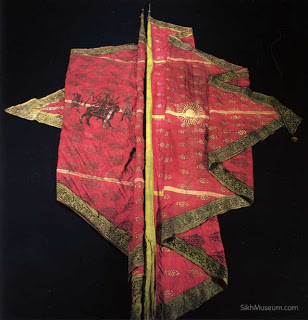
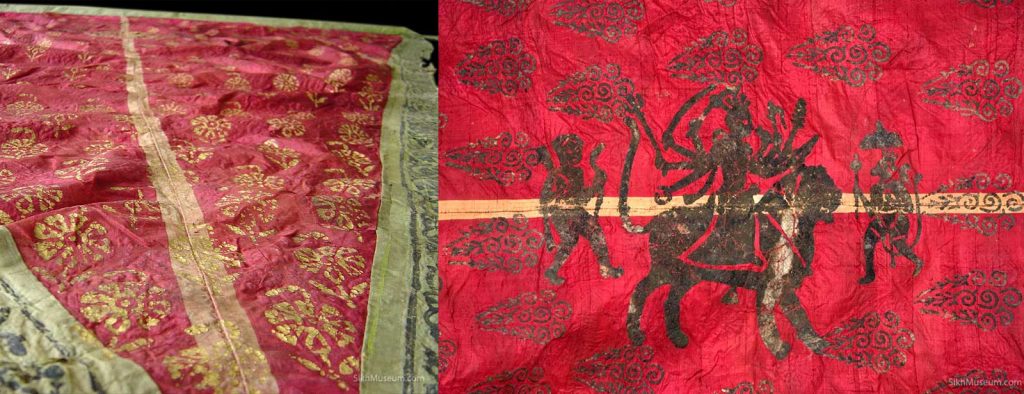
Khalsa Armies with Banner displaying motif of Goddess Varahi, the Hindu Goddess of War.
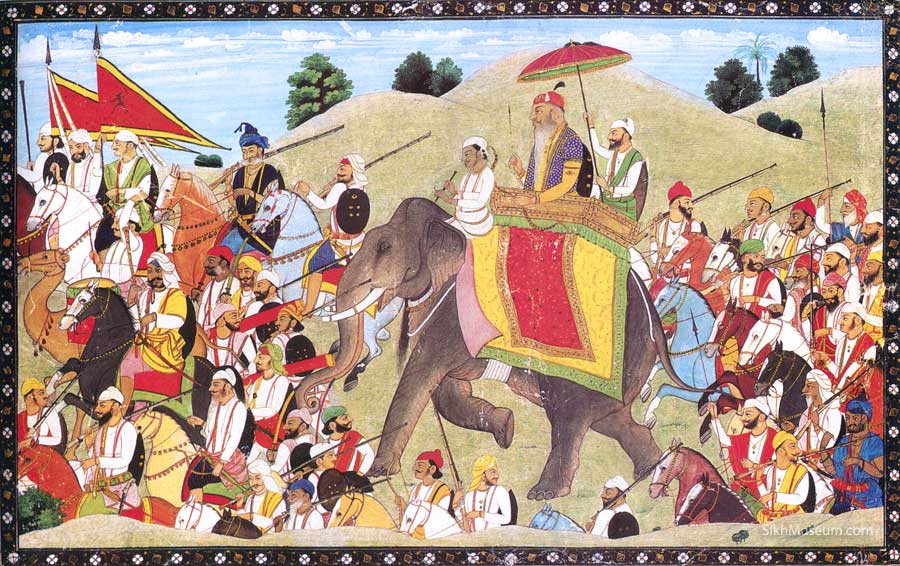
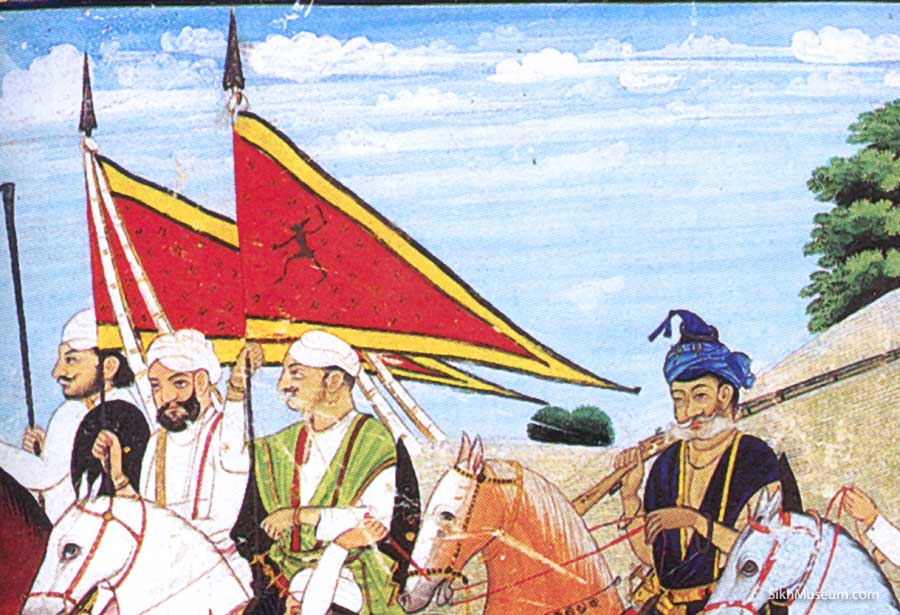
Khalsa Armies with Banner displaying motif of Goddess Varahi ,the Hindu Goddess of War.
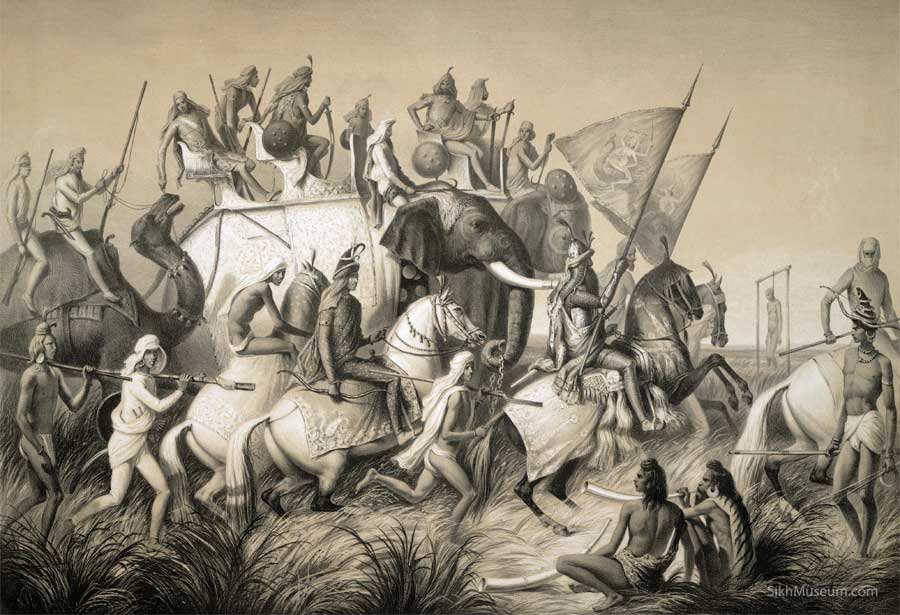
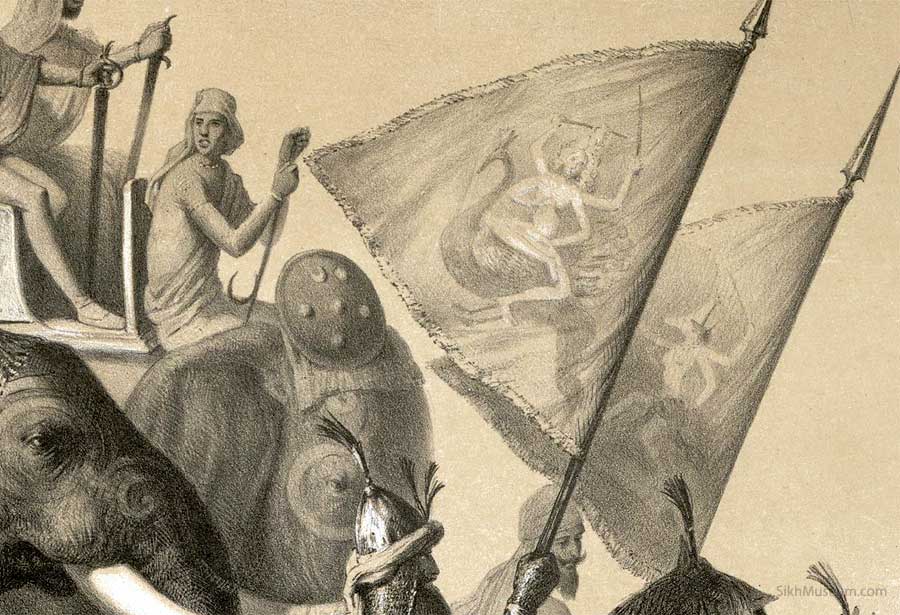
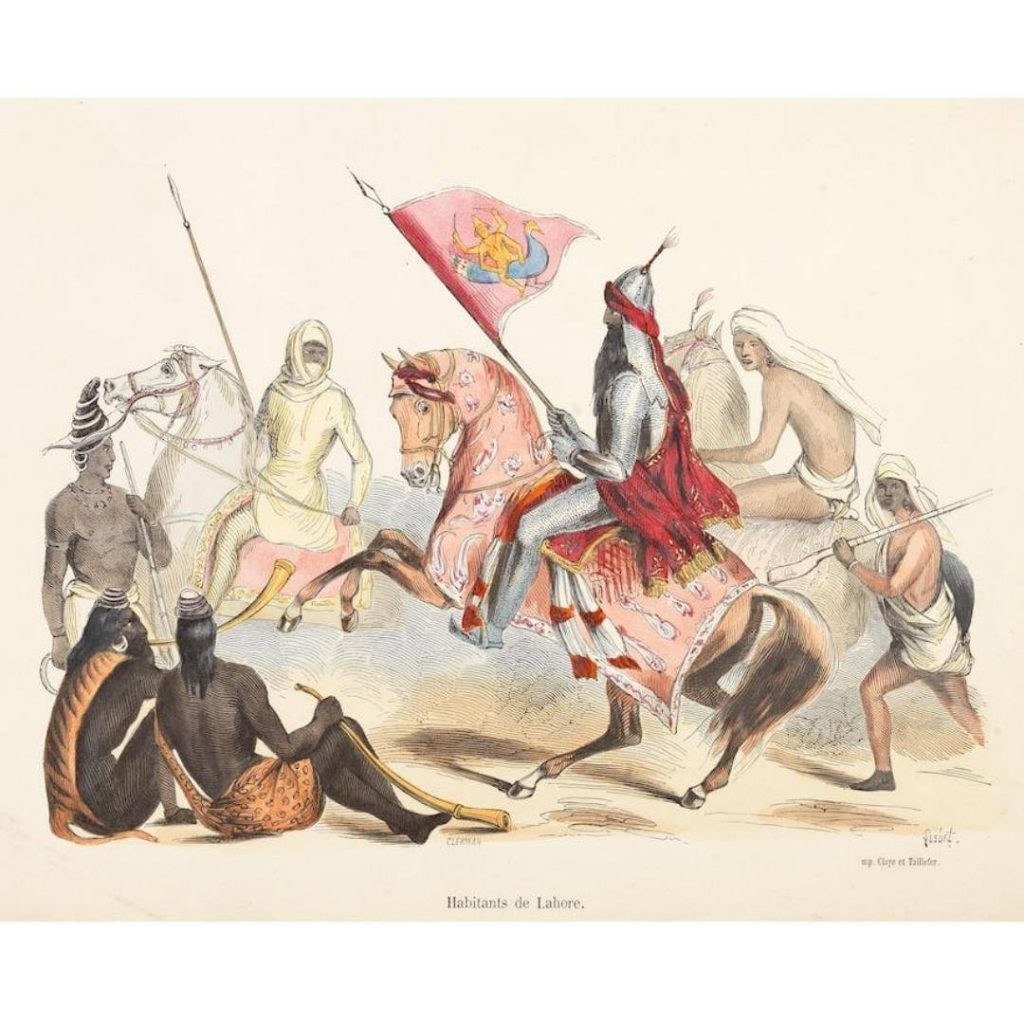
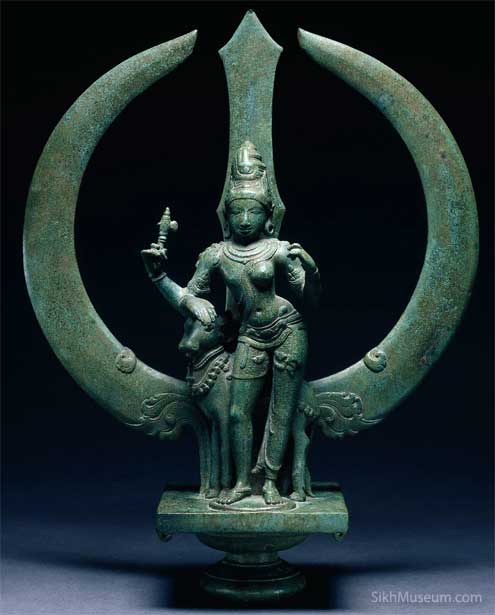
As explained by the Buddha Dal which is the oldest faction of the Nihang sect :
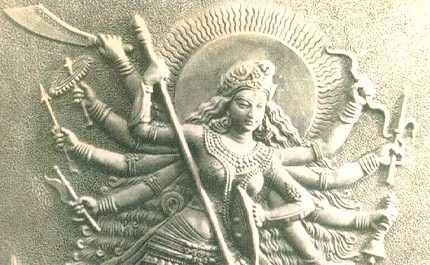
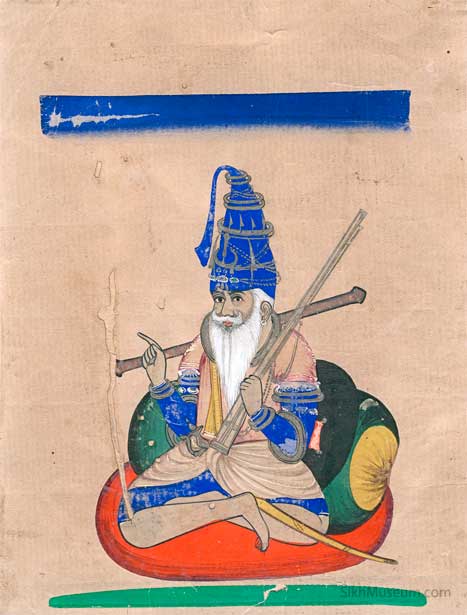
Nihang Chieftain – ca. 19th century, paint on paper, Gurmit Singh & Satnam Singh Collection
TO BE CONTINUED…
You may like
-


Seven Vows and Steps (pheras) of Hindu Wedding explained
-


Sari or Saree is symbol of Indian feminism and culture
-


Atithi Devo Bhava meaning in Hinduism and India
-


Significance of Baisakhi / Vaisakhi
-


Navaratri: The Nine Divine Nights of Maa Durga!
-


Significance of Bilva Leaf – Why is it dear to Lord shiva?
Fesitvals
Significance of Baisakhi / Vaisakhi
Published
4 years agoon
April 13, 2021By
Vedic Tribe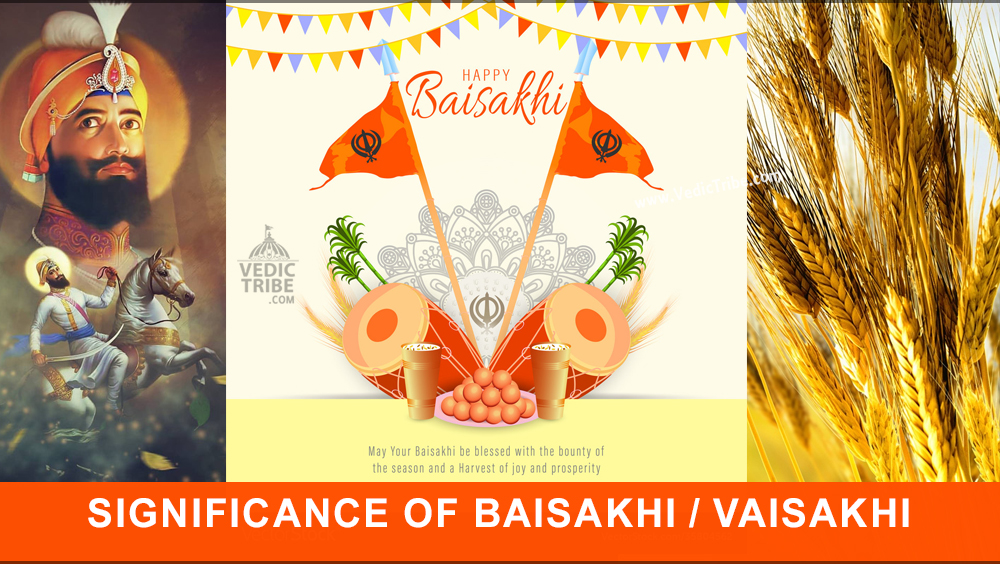
Baiskhi is also spelled ‘Vaisakhi’, and is a vibrant Festival considered to be an extremely important festival in India. It is celebrated all over India under different names and rituals.
Astrological Significance of Baisakhi
The festival of Baisakhi falls on April 13 every year and April 14 once in every 36 years. Change in date is because of the fact that date of Baisakhi is reckoned according to the solar calendar. Astrologically, the date of Baisakhi is significant as marks sun’s entry into Mesh Rashi.
For this very reason, many people also know Baisakhi as Mesha Sankranti. The auspicious date of Baisakhi is celebrated all over India under different names and rituals. It is celebrated as ‘Rongali Bihu’ in Assam, ‘Naba Barsha’ in Bengal, ‘Puthandu’ in Tamil Nadu, ‘Pooram Vishu’ in Kerala and ‘Vaishakha’ in the state of Bihar.
Significance of Baisakhi for Farmers
For the agriculturally rich state of Punjab and Haryana, Baisakhi marks the time for harvest of Rabi (winter) crops and is therefore extremely significant for the farmers. Baisakhi Festival is also celebrated as a Thanksgiving Day festival in these states. After waking up early and dressing themselves in new clothes, farmers visit temples and gurdwaras to express gratitude to God for the good harvest and seek blessing for ensuing agriculture season. Farmers also celebrate Baisakhi by performing energetic bhangra and gidda dance and participating in Baisakhi Fairs.
Significance of Baisakhi in Sikhism
Baisakhi is of major importance for the people following Sikh faith. As it was on a Baisakhi Day, in the year 1699 that the Tenth Guru of Sikhs, Guru Gobind Singh founded Khalsa Panth or the Order of Pure Ones and gave a unique identity to Sikhs. On the same day the guru administered amrit (nectar) to his first batch of five disciples making them Singhs, a martial community. By doing so, he eliminated the differences of high and low and established that all human beings were equal.
Baisakhi is New Year’s Day in Punjab. It falls on the month of Vaisakh. This festival marks the ripening of the Rabi harvest. The day coincides with the solar equinox on the13th of April. It was on this day that the tenth Sikh Guru, Guru Gobind Singh, founded the Khalsa (the Sikh brotherhood) in 1699. For Sikhs, this is as a collective birthday. It is celebrated on April 13, though once in 36 years it occurs on 14th April.
Sikhs celebrate Baisakhi by participating in special prayer meetings organized at gurdwaras. They also carry out joyful Baisakhi processions to mark the day.
Significance of Baisakhi in Other Religions
The day of Baisakhi is of significance for the Hindus as it was on this day in 1875 that Swami Dayanand Saraswati founded the Arya Samaj – a reformed sect of Hindus who are devoted to the Vedas for spiritual guidance and have discarded idol worship. Besides, Baisakhi day is of relevance for the Buddhists as Gautama Buddha attained enlightenment and Nirvana on this auspicious day.
In Kerala, the festival is called ‘Vishu’. It includes fireworks, shopping for new clothes and interesting displays called ‘Vishu Kani’. These are arrangements of flowers, grains, fruits, cloth, gold, and money are viewed early in the morning, to ensure a year of prosperity.
In Assam, the festival is called Bohag Bihu, and the community organizes massive feasts, music and dancing. Bengalis mark it as new years day or ‘Naba Varsha’ or Pohela Boishakh in Bengal, Assam and Tripura.
Puthandu (Tamil New Year) in Tamil Nadu. Whatever the history says, today Baisakhi is celebrated with all pomp and show in almost all parts of the country.
Hinduism
Brahmins who Sacrificed for Sikhs and Sikh Gurus
Published
4 years agoon
December 13, 2020By
Vedic Tribe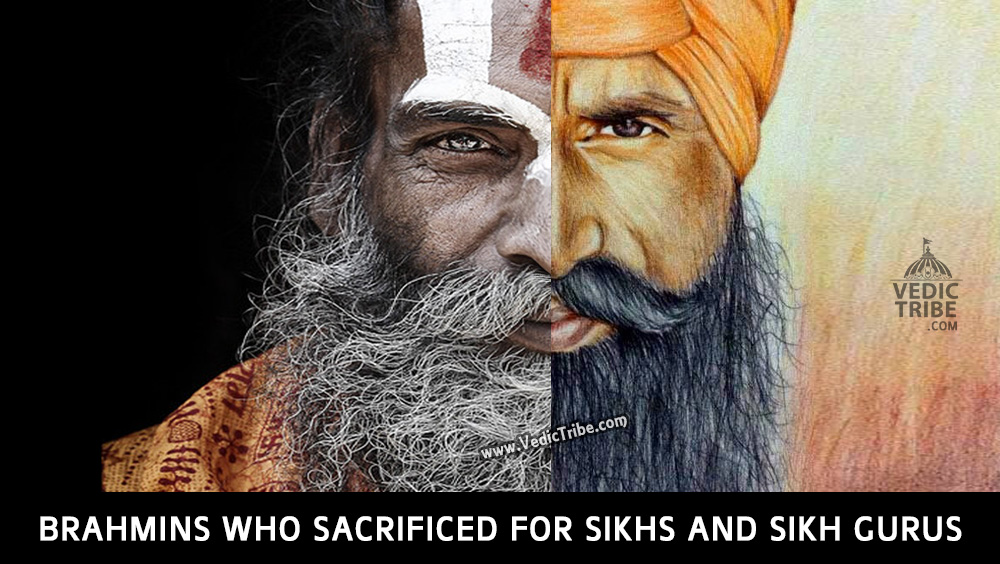
Read in Hindi below English version
Usually people from the Sikh society and the separatist Khalistani Jatts use very condemnable hateful words towards Brahmins. For a mistake of a Brahmin named Gangu, they blame the whole Brahmin society, call them coward and traitors. But these Pakistani supporting and brainwashed people do not know that the most soldiers in the army of Sikh Gurus were from the Brahmin society.
1. Pandit Praga Das Ji
2. Pandit Peda Ji
Pandit Peda Das ji was also the main ally of Guru Arjun Dev ji and he was the chief commander of the army of Sikh Guru Hargovind Singh ji. He took part in all the battles alongside with Guru Ji and finally got martyred in the battle of Amritsar.
3. Pandit Mukunda Ram Ji
4. Pandit Jattu Das Ji
5. Pandit Singha Purohit Ji
6. Pandit Malik G Purohit
7. Pandit Lal Chand Ji
8. Pandit’s Kripa Ram ji
9. Pandit Sanmukhi Ji
10. Pandit Chopad Rai Ji
11. Pandit Mathura ji
12. Pandit Kirat ji
13. Pandit Balu ji
14. Pandit Sati Das ji
15. Pandit Mati Das Ji
16. Bajirao Peshwa
ब्राह्मणों द्वारा सिक्खों के लिए दिए गए बलिदान :-
1. पंडित प्रागा दास जी
2. पंडित पेड़ा जी
3. पंडित मुकुंदा राम जी
4. पंडित जट्टू दास जी
5 .पंडित सिंघा पुरोहित जी
6. पण्डित मालिक जी पुरोहित
7. पंडित लाल चंद जी
8. पंडित किरपा राम जी
9. पंडित सनमुखी जी
10. पंडित चोपड़ राय जी
11. पण्डित मथुरा जी
12. पण्डित किरत जी
13. पण्डित बालू जी
14. पण्डित सती दास जी
15. पण्डित मति दास जी
16. बाजीराव पेश्वा
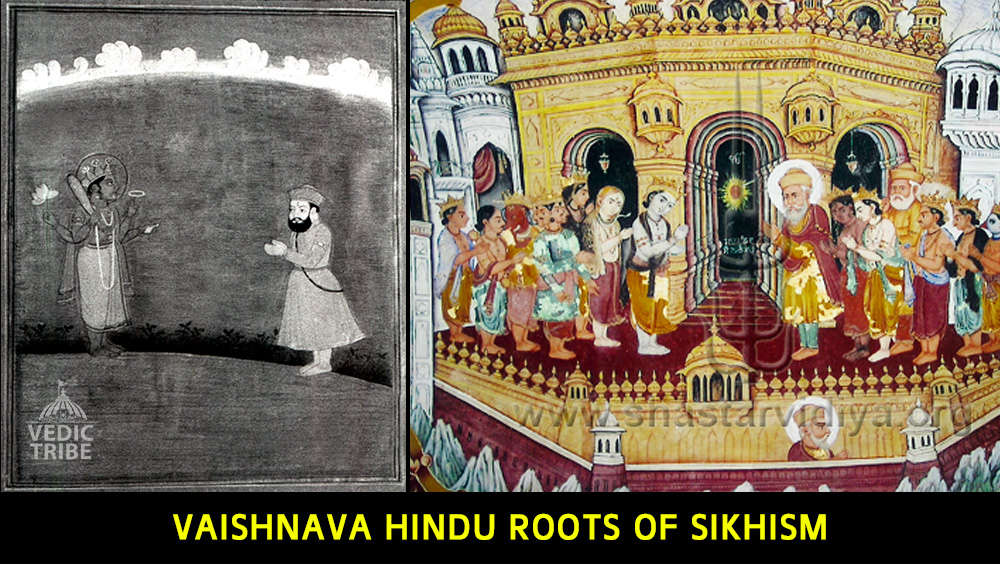
There is an active movement going on today in which orthodox members of the Sikh community are working to protect the sanatana heritage from which their Sikh religion grew. They are challenged by a modern faction of the Sikh community who is accused by them of re-writing Sikh history in a more Abrahamic mood, distancing it from Hindu culture and history, and the Vaisnava roots evident in many texts and paintings that record early Sikhism.
A few examples of these paintings are shown above and below. Above, Guru Nanak is seen offering pranams to a mendicant Lord Shiva, standing on a body in Kali-like posture. It was done in the early to mid-19th Century like the one below, which shows Guru Nanak offering pranams to Lord Vishnu. In this one, Guru Nanak is wearing a seli topi (hat) and tilak.
Images like these are taken by many Sikhs as evidence that Sikhism is indeed a panth, or pathway in the sanatana family, although the Hindu roots of the religion are now actively suppressed by historical reformers. The image just below of Nanak worshipping Vishnu is known as a puraatan painting, a rare example of this style of painting that is housed in the collection of Shimla Museum. The puraatan paintings are illustrations to Puraatan Raagis, or Sikh traditional raagas.
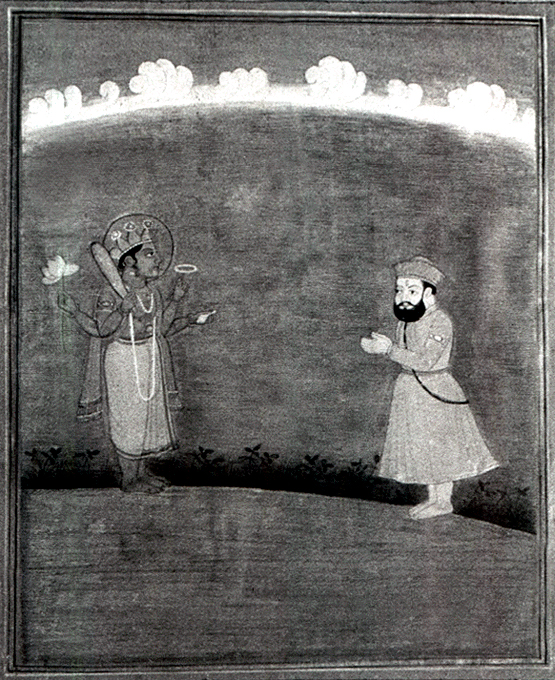
Nanak worshipping Vishnu is known as a puraatan painting, housed in the collection of Shimla Museum.
The Shri Adi Guru Granthji was written and compiled in accordance with the prescribed Ragas taken from the Sama Veda. This ancient treatise deals with the science of musical notes, ragas, dance and theatre. The Shabads, which are all arranged in chapters in the Shri Adi Granth, bear the names of the Ragas, and each is sung in the specific raga given by the Bhatt Brahmins, who are raagis (classical singers). Further, the Raga for each Shabad or hymn of Adi Granthji is set to a specific numerical rhythmic notation, or tala. This ancient tradition goes back to the Vedic Era, and is primary evidence of the real source of Sikh religion and culture.
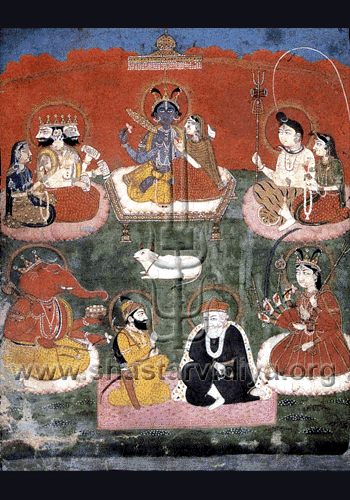
Guru Nanak with Trimurti, Ganesh and Durga
Traditional ragas, which express the devotee’s desire to become absorbed in the Supreme Lord, are arranged over a period of twelve months. Singing of the Ragamala is a form of worship which typically precedes an offering of bhog. Today, however, this tradition is also disappearing in Sikh gurudvaras, being replaced with a non-musical chanting or reading of the Banis.
The traditional Naam (mantra) Shabd sung by Sikh musicians in Raga style are now sadly being replaced with contrived tunes — some even set to Bollywood music. This is evidence of the same sort of deterioration of pure Krsna kirtan we find in the modern so-called ‘kirtaniya’ movement of the Bhakti Yoga community. Vociferous beating on tablas and wailing on harmoniums has replaced the refined, skilled Vedic musical offering of traditional ragas, and therefore the devotional mood is being lost.
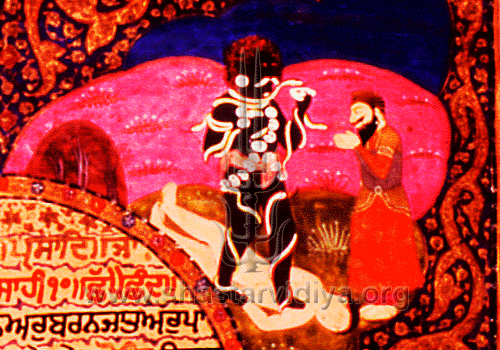
Worshiping Maa Kali
In the photo above we see a class of schoolboys at Shri Harimandirji, the Sikh equivalent of gurukul at the Golden Temple in Amritsar. The boys are all wearing turbans, in the common style found all over Northern India. In the background there are several Hindus, along with one Brahmin teacher, and some others who haven’t covered their heads.
Orthodox Sikhs dedicated to their sanatana roots take this photo as one of many that help to establish the reality of the Vaisnava presence in Sikh culture. Historical evidence shows that inside the Harimandirji at that time, there were also murtis of Vaisnava deities, which were removed or destroyed by Christian missionaries under the British Raj.

Sadhus meditating at Golden Temple – 1904
In the far background are visible several Sikh Miri Piri flags, bearing the dhal, kattar and khanda (shield, dagger and emblem). The first two of these symbols are traced back to the paraphernalia of Durga Ma, and again help to establish the Vedic roots of Sikhism.
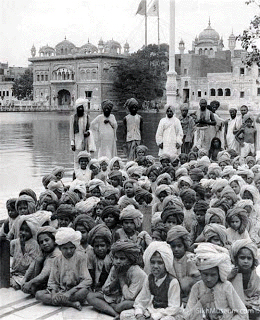
Shri Harimandirji – Golden Temple, c. 1904
In the photo above we see a class of schoolboys at Shri Harimandirji, the Sikh equivalent of gurukul at the Golden Temple in Amritsar. The boys are all wearing turbans, in the common style found all over Northern India. In the background there are several Hindus, along with one Brahmin teacher, and some others who haven’t covered their heads.
Orthodox Sikhs dedicated to their sanatana roots take this photo as one of many that help to establish the reality of the Vaisnava presence in Sikh culture. Historical evidence shows that inside the Harimandirji at that time, there were also murtis of Vaisnava deities, which were removed or destroyed by Christian missionaries under the British Raj.
In the far background are visible several Sikh Miri Piri flags, bearing the dhal, kattar and khanda (shield, dagger and emblem). The first two of these symbols are traced back to the paraphernalia of Durga Ma, and again help to establish the Vedic roots of Sikhism.
In traditional paintings, the Gurus never wore turbans, a custom that even according to Sikh teaching itself was only instituted by the tenth and last Guru, Govind Singh, in 1699. All the Gurus are typically shown as wearing a topi (Hindu-style cap) and patka (sash). We discuss one instance.
K.C. Aryan (born 11 August 1919, died 2002), a Partition refugee from West Panjab, was an accomplished painter. He founded the Museum for Tribal and Folk Art in Gurgaon, still functioning today. He saved plenty of old paintings, sculptures and other arts & crafts objects for posterity by collecting them in his museum or donating them to more established institutions.
In 1970, he presented to the publishing unit of Punjabi University Patiala a manuscript with illustrations for a book, 100 Years Survey of Panjab Painting (1841-1941). It was eventually published by the PUP in 1975, but only in mutilated form. The Senate Board of the University objected to the inclusion of one particular painting, and threatened that if it were published, the grant for the whole publishing unit would be stopped.
K.C. Aryan donated the painting in ca. 1982 to the Himachal State Museum in Shimla. There, it is significantly not on display but kept in storage. That is, if it has not been lost or illegally sold by some babu unconcerned with art and heritage; or somehow eliminated by one with Khalistani leanings eager to destroy the evidence for an inconvenient fact: that Guru Nanak was every inch a Hindu.
Follow us on Facebook
Follow us on Twitter
Latest


Seven Vows and Steps (pheras) of Hindu Wedding explained
Views: 6,403 Indian marriages are well renowned around the world for all the rituals and events forming part of the...


Sari or Saree is symbol of Indian feminism and culture
Views: 5,542 One of the most sensual attires of a woman in India is undoubtedly the sari. It is a...


Atithi Devo Bhava meaning in Hinduism and India
Views: 4,790 Atithi Devo Bhava, an ancient line taken from the Hindu scriptures and was originally coined to depict a visiting person whose...


Sanskrit Is More Than Just A Method To Communicate
Views: 4,004 -By Ojaswita Krishnaa Chaturvedi anskrit is the language of ancient India, the earliest compilation of sound, syllables and...


Significance of Baisakhi / Vaisakhi
Views: 4,924 Baiskhi is also spelled ‘Vaisakhi’, and is a vibrant Festival considered to be an extremely important festival in...


Navaratri: The Nine Divine Nights of Maa Durga!
Views: 5,975 – Shri Gyan Rajhans Navratri or the nine holy days are auspicious days of the lunar calendar according...


History of Vastu Shastra
Views: 8,411 Vastu Shastra (or short just Vastu) is the Indian science of space and architecture and how we may...


Significance of Bilva Leaf – Why is it dear to Lord shiva?
Views: 7,665 – Arun Gopinath Hindus believe that the knowledge of medicinal plants is older than history itself, that it...


Concept of Time and Creation (‘Brahma Srishti’) in Padma Purana
Views: 8,514 Pulastya Maha Muni affirmed to Bhishma that Brahma was Narayana Himself and that in reality he was Eternal....


Karma Yoga – Yog Through Selfless Actions
Views: 7,936 Karma Yoga is Meditation in Action: “Karma” means action and “yoga” means loving unity of our mind with...

